Tube Baits Are Gitzits, A Gitzit Is A Tube, Uh?
No Matter What You Call It - Action Is Its Middle Name!
Plastic Fishing Tubes
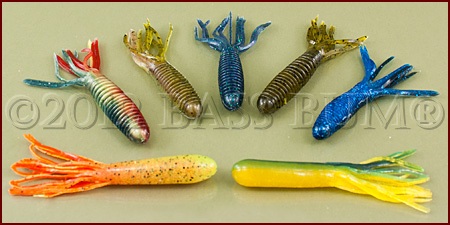
What's the nature of tube baits?
Tube lures are nothing more than a hollow tube made of soft plastic with one end closed and 25-40% of its open end (butt) sliced into thin strips. So what's the deal with that? Well, these little tentacles float and move enticingly when the tube bait is dropping slowly to the bottom, being worked by the angler or even sitting still. These tentacles provide very nice action.
Smallmouth can't stand this and will aggressively strike them, so they say. Listen, these are great artificial baits but we all know a smallmouth will and does ignore anything it darn well pleases if it's not in the mood. There is no perfect lure. But a tube is indeed an effective one and I almost always have one rigged-up on deck.
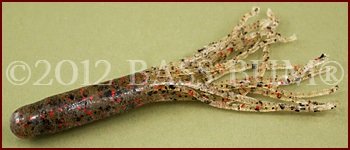
In addition to the tentacles the hollow structure also contributes greatly to the "action" of this soft plastic lure. The hollow core traps air causing it to "float", not literally, but slowly as it drops spiraling toward the bottom. This is not unlike the almost perpetual circling movement of a pod of shad. Once on the bottom, it reflects the characteristics of a crawfish, perhaps one of the reasons it's effective on smallmouth. If lightly twitched when falling, a tube will dart unpredictably enticing strikes.
Gitzits, or tube fishing lures, were originally designed in the mid 1970's for casting on light lines with small jigheads but are rigged and presented in many different ways today. There is no one right way to rig a tube bait. It seems everybody has their own opinion usually based on what has worked for them.
That's what you should do.
Figure out what rig and presentation work best for you when being fished in your hands.
Me? Well, as a student of the sport and a junk fisherman, I fish a gitzit several different ways. Experimentation after all, is the true method of knowledge and growth. I have no idea who said that originally but it sounds good uh?
Nevertheless, the following are several rigging schemes for bass fishing tubes.

Tube Rigging Options 101
- Texas Rig - When using an offset hook it's very much like rigging a worm.
- The hook point is entered through the top of the head to about 1/4" or to the beginning of the bend or curve of the hook.
- It is then exited the side and pulled through till the offset bend is through the tube and the eyelet remains outside the head.
- Twist the hook so the point is toward the tube.
- Measure the re-entry point on the side of the tube, then push it through the bottom of the body and the hooks point into the top of the body.
- Then do one of the following with the hook point:
- Texas Rig - For heavy cover do not push the hook point "completely through" the upper surface, merely embed the point.This makes it weedless while still allowing the hook point to easily penetrate the plastic and the bass' jaw.
- Texposed - If cover is thin, use a Mustad Bigmouth Tube Hook hook and push the hook point completely through the other side of the body. You will notice the shape of the hook allows the point to lie on top of the tube's top surface.
- Texskin - For a bit heavier cover you might want to go a step further and actually put the point of the hook just under the skin of the tube. Do this as you would with a worm, pull the hook point and tube skin apart then bury the point under the skin as you push the skin back over it.
- Lead Jig - This is a more basic method of rigging a tube bait.
- Choose an appropriate weight lead jig head and insert it into the butt of the hollow body pushing it to the very end where it is stopped by the solid head.
- Force the eyelet of the lead jig through the plastic so it protrudes outside the tube.
- Tie your line directly to the eyelet and push it back into the body.
- There you have it, a tube jig.
Clear As Mud? How About Some Pictures?
You know the saying about a picture being worth a thousand words. There is a lot of truth in that. Don't know about you but show me once and I got it. If I read it three times I'm still scratching my head.
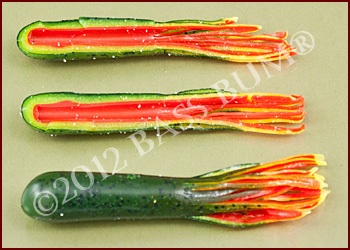
I thought it might help to cut a tube in half and use it to illustrate rigging alternatives. It gives a little different perspective and better understanding I think.
Let's look first at Texas rigging tube baits then we'll see how it's done using a simple jighead.

Texas Rigging A Tube
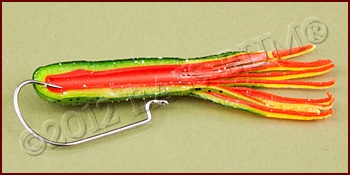
(1) Insert the hook point in the head of the tube as you would a worm. Bury it up to the first bend or where the curve begins, which will be approximately 1/4".
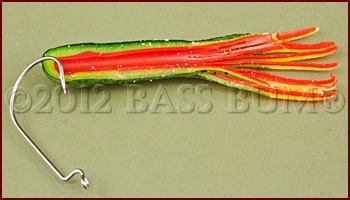
(2) Once in, direct the point of the hook toward the side of the tube and exit the tube.
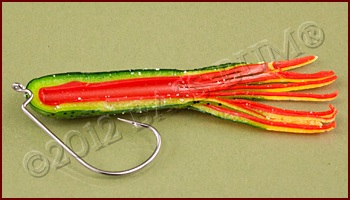
(3) After pulling the hook through to the offset twist the hook so the point is toward the tube body.
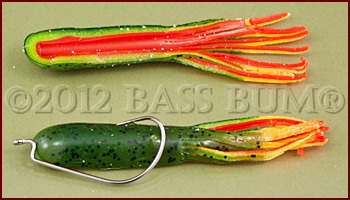
(4) Lay the hook beside the tube and note the place where the hook shaft intersects the tube body. It is here where you want to penetrate the tube with the hook point. You will need to pinch up the tube body in order to insert the hook point in the correct spot.
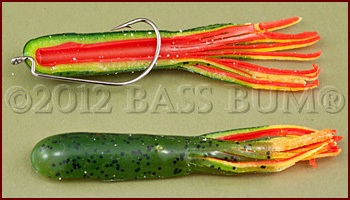
(5) Penetrate the outer wall of the tube and push the hook point completely through the bottom wall of the tube.
But, if you plan on truly Texas rigging the hook, do not penetrate the opposite wall and exit the tube. Instead, bury the hook point into the wall so the point is just subsurface. Here it will be weedless but still capable of easily penetrating the small amount of plastic covering it when you set the hook.
Alternatively, if in light or no cover, you may wish to completely penetrate the opposite wall and "rest" the hook point on the back of the tube in what is called a "Texposed" fashion.If you use the Mustad Mega-Bite hook as shown above, or Mustad Big-Mouth Tube Hook, this is easily accomplished.
Rigging Tubes With Jigheads
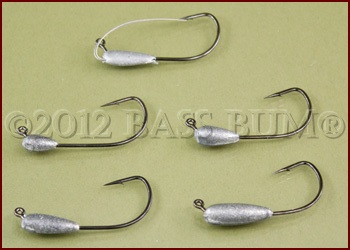
When fishing tube baits in light cover, a 3" long tube with a
jighead weighing 1/8 or 3/16 ounces on a 2/0 hook rigged on spinning
tackle fits the bill. I've been very successful catching smallmouth on
the shorter tubes. If you're fishing tube baits that are 4 to 4 1/2",
which is good for typical largemouth bass fishing, heavier 1/4 or 3/8
ounce jigs are in order.
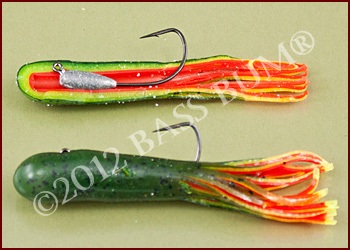
Rigging tube baits with an internal jighead is quite easy. Merely insert the jighead into the open butt of the tube, think colonoscopy. If you're over fifty you know what I'm talking about. Push the jig till it stops against the head then push the eye through the plastic. The hook point will, or at least should, be extending out the back of the tube.
Tube Jig Meets Tube Butt!
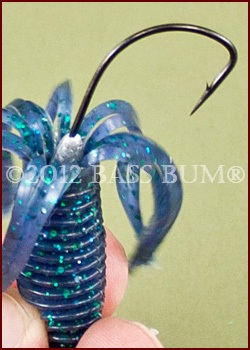

Rigging Wrinkles
Beyond Texas rigging and tube jigheads are there other ways to rig tube baits? Sure, there are many. Here are a few:
Owner Phantom Tube Hook
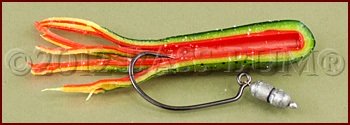
(1) First, place the hook point inside the butt of the tube bait keeping the weight away from its side.
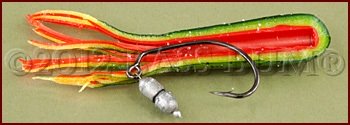
(2) Next, thread the tube over the full length of the hook. Then exit the hook point from the tube.
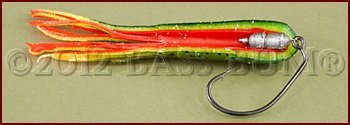
(3) Pull the hook through which will drag the weight into the tube body.
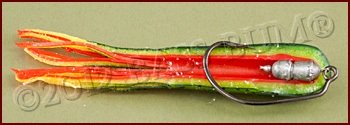
(4) Align hook against tube body to determine the re-entry point of hook. Then push hook through both walls of the tube and Texskin the point in the skin surface. To tie on your line merely push the eye through the body wall, tie on and push the eye back into the body.

Bass Pro Shop XPS Tube Weights
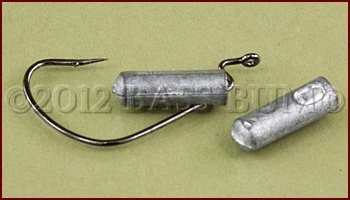
The small weights shown at right are Bass Pro Shop XPS Tube Weights, though a couple of other companies make them as well. These weights have an open end and an opening in the side. You can get them with or without rattles.
As you would a jighead you push the weight in the butt of the tube bait till it stops. You insert your hook point in the head of the tube making sure to pass through the hole in the end of the weight and then through the side opening and out of the tube.
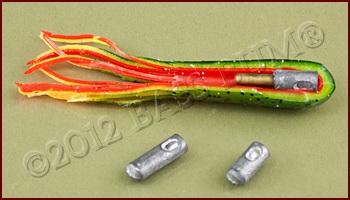
Just Put Your Tubes On A Weedless Jighead
This is simple and effective if you're looking for a weedless setup. Almost any shape jighead will do. Just use your imagination.
What About Fishing Tubes?
Fishing tube lures for bedding bass can be very effective but should you
choose to do this I urge you to adhere to "catch and release" and
return the bass to the water.
Take some brief time for a photograph then release it so it can quickly return to the bed. Large flipping tubes are one of the best bass lures for grass and reeds. Why? Because they're an excellent imitation crawfish bait.
Learn about rigging and fishing tubes
Return To Bass Fishing Lures From Tube Baits
